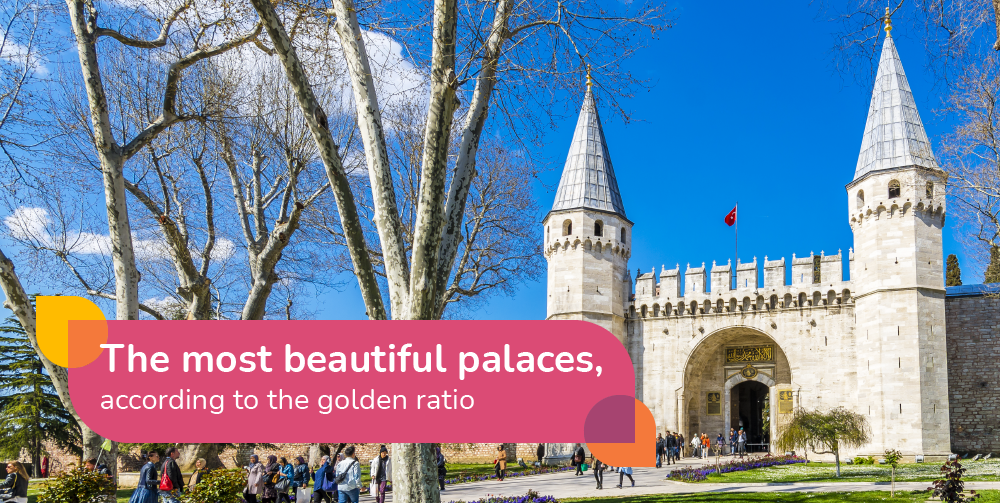Palaces around the world are of interest to both tourists and locals. From England’s iconic Buckingham Palace to Germany’s Neuschwanstein Castle, there really is a palace in every shape, size, and style. But which palace is the most statistically beautiful according to science?
Interested in finding out, money.co.uk utilised the golden ratio to determine which of the world’s palaces is the most beautiful. To do this, they compared each palace’s dimensions to the golden ratio, a mathematical ratio which can be found in nature, architecture, and even music, that indicates a balanced and aesthetically pleasing composition. Money.co.uk were then able to determine how close the palace’s dimensions are to the golden ratio – the smaller the percentage difference, the more statistically beautiful the palace.
England:
The world’s most scientifically beautiful palaces
|
|
Palace |
Country |
Height/width ratio |
Percentage difference from golden ratio |
|
#1 |
Topkapi Palace |
Turkey |
1.572 |
3% |
|
#2 |
Mysuru (Mysore) Palace |
India |
1.690 |
4% |
|
#3 |
Forbidden City (The Gate of Divine Might/Shen-Wu Gate) |
China |
1.783 |
10% |
|
#4 |
Schönbrunn Palace |
Austria |
1.359 |
16% |
|
#5 |
Neuschwanstein Castle |
Germany |
2.000 |
24% |
|
=#6 |
Imperial Palace Tokyo |
Japan |
1.133 |
30% |
|
=#6 |
Château De Chambord |
France |
1.125 |
30% |
|
#8 |
Palais des Papes |
France |
2.158 |
33% |
|
#9 |
Kensington Palace |
England |
2.375 |
47% |
|
#10 |
The Grand Palace (Chakri Mahaprasad Hall) |
Thailand |
2.813 |
74% |
|
#11 |
Potala Palace |
China |
3.077 |
90% |
|
#12 |
Umaid Bhawan Palace |
India |
3.520 |
118% |
|
#13 |
Alhambra (Palace of Charles V) |
Spain |
3.706 |
129% |
|
#14 |
The Royal Palace of Stockholm |
Sweden |
3.788 |
134% |
|
#15 |
The Royal Palace |
Spain |
3.970 |
145% |
Money.co.uk also revealed that the world’s most statistically beautiful palace is Topkapi Palace in Istanbul, Turkey. The palace’s width/height ratio worked out at 1.572, which is just 3% off the golden ratio’s proportions.
Just behind, with a difference of 4% from the golden ratio, is Mysuru (Mysore) Palace in India.
Coming in third, and differing 10% from the golden ratio’s proportions, is the Forbidden City Palace in Beijing, China.
The world’s least scientifically beautiful palaces
|
|
Palace |
Country |
Height/width ratio |
Percentage difference from golden ratio |
|
#1 |
Dolmabahçe Palace |
Turkey |
7.972 |
393% |
|
#2 |
Hampton Court Palace |
England |
6.389 |
295% |
|
#3 |
Buda Castle |
Hungary |
5.175 |
220% |
|
=#4 |
Drottningholm Palace |
Sweden |
5.160 |
219% |
|
=#4 |
Palace of Versailles |
France |
5.158 |
219% |
|
#6 |
Presidential Palace (Palacio de Gobierno) |
Peru |
4.613 |
185% |
|
#7 |
Buckingham Palace |
England |
4.500 |
178% |
|
#8 |
Windsor Castle |
England |
4.361 |
169% |
|
#9 |
Chateau De Fontainebleau |
France |
4.337 |
168% |
|
#10 |
Winter Palace |
Russia |
4.179 |
158% |
Despite being home to the ranked most beautiful palace, Topkapi Palace, the results found that Istanbul was home to the least statistically beautiful palace analysed, Dolmabahçe Palace. The palace’s height/width ratio was 7.972 due to the width of the palace, meaning it is a staggering 393% away from the golden ratio’s proportions.
Three of England’s palaces feature in the bottom 10, with the least statistically beautiful being Hampton Court Palace, again due to its wide proportions. Hampton Court Palace shows a difference of 295% to the golden ratio, placing it second from bottom.
Third from last is Buda Castle in Hungary, which shows a difference of 220% from the golden ratio with a height/width ratio of 5.175.
For more information, please see money.co.uk’s full blog post: https://www.money.co.uk/home-insurance/most-beautiful-palaces
Methodology:
- Money.co.uk wanted to find out which palaces around the world are the most scientifically beautiful.
- To do this, money.co.uk collated a list of the 50 most famous palaces, and then searched each palace’s name into SEMrush to find which are searched for the most on Google in order to determine the 25 most popular.
- Next, money.co.uk sourced the dimensions of the façade of each palace (base width and height) using a combination of reliable online sources and Google Earth Pro in order to apply the golden ratio to each structure.
- The dimensions were then used to calculate the percentage difference from the dimensions of each palace to the golden ratio.
- Each palace was ranked based on which palaces’ façade was closest to the golden ratio where the smallest percentage difference indicated a more scientifically beautiful palace.
*In the cases where the palace was not a single building, but a complex of palaces, the most representative palace was chosen:
- Palace of Charles V, Alhambra
- Chakri Mahaprasad Hall, The Grand Palace
- The Gate of Divine Might/Shen-Wu Gate, Forbidden City
- Main entrance, Topkapi Palace
